Customer journey and buying circle are two concepts that are closely related and important for understanding how consumers make purchasing decisions. It’s important to note that both the customer journey and buying circle are not linear processes. Customers may loop back to previous stages, especially if they face challenges or find new information. Successful businesses understand these processes and use them to tailor their marketing, sales, and customer support strategies for seamless customer experience.
Often these two terms are used interchangeably or incorrectly while discussing the customer journey using buying stage terms. Therefore, let’s define the difference:
Customer journey describes the path and touch points a consumer makes toward a purchase, while buying circle describes the process that a customer goes through towards making a purchase and focuses more on the seller’s perspective.
These terms can be also mixed with the term “sales funnel”, as it is a more relatable concept. Read more on sales funnel in our previous blog post.
Buying Circle
The buying circle (or sales circle), represents the process that a customer goes through while making a purchase. It focuses more on the seller’s perspective and the steps they take to guide customers toward making a purchase. The sales circle can vary in length and complexity depending on the industry as well as the product.


The typical stages in a buying circle are as follows:
1. Prospecting Leads
The seller identifies potential customers who might be interested in their product or service. Here are the possible ways how it can be done:
- Meeting people at events
- Lead generation ad campaigns
- Researching (e.g., LinkedIn)
- Referrals
2. Contact
- Emails (including personalised automated ones)
- Calling
- Arranging a meeting
3. Lead Assessment
The seller tries to understand the customer’s needs, pain points through extensive research aiming to present a tailored solution. Marketing Automation and CRM platforms can provide your sales with qualitative data for lead assessment.
4. Presentation
The seller presents their product or service to the prospect, highlighting its features and benefits addressing the pain points identified at the lead assessment stage.
5. Handling objections
The seller addresses any concerns or objections the prospect may have about the purchase. If the assessment stage was conducted carefully, handling objections usually goes smoothly.
6. Closing the deal
The seller persuades the prospect to make the purchase, finalising the deal. Depending on the nature of your business, this stage can involve:
- Delivering a quote
- Finalising negotiations
- Signing a contract
- Sending order confirmation email
7. Lead nurturing and after-sales service
After the sale, the seller maintains contact with the customer, ensuring their satisfaction and addressing any post-purchase issues. If conducted well it can lead to repeat purchases and increase in customer retention
- Sending nurturing emails
- Arranging follow-up meetings
- Providing after-sales service
- Asking for references.
Customer Journey
The customer journey on the other hand refers to the process that a potential customer goes through when interacting with a brand or business, from the initial point of awareness to the final decision-making stage and beyond. It encompasses all the touchpoints and experiences a customer has with a brand, both online and offline.
In one of our previous articles we covered topics on customer journey and its mapping, here’s an illustration of customer journey with a simple example.


The customer journey and buying circle are theoretical concepts which allow you to view your business through different perspectives of interaction with customers. Visualising and adapting this information based on changes and new discoveries would be advantageous for the entire team. It would help in optimising your marketing, sales, and customer service strategies to enhance customer satisfaction and drive business growth.
What's next for you?
Clarifying a customer journey and buying circle can be a challenging process at the beginning. Our team at “Lead Gen and CRM” have been helping Southeast Asian clients to design their customer journey and automate lead generation campaigns. Our marketing automation and CRM platform powered by OpenMinds, includes features that help you to decrease operational costs and make sales and marketing efforts more transparent for the whole organisation. Reach out to us for a free consultation on customer journey and lead generation for your particular business.





